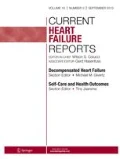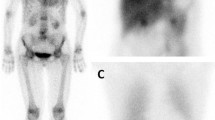Abstract
The influence of the renin-angiotensin system (RAS) is recognized in cardiac and vascular injury. An extrinsic RAS has been known for decades, and an equally important intrinsic RAS has been discovered recently. The latter leads to pathologic tissue alterations in the absence of systemic stimuli and may be the main source of local tissue effects of RAS. A new radiotracer [18F]fluorobenzoyl-lisinopril was synthesized by radiolabeling benzoic acid active ester with 18F and reacting that with the epsilon-amino group of lisinopril. The presence of angiotensin-converting enzyme (ACE) activity and angiotensin II receptors was examined in relation to myocardial fibrosis. This tissue-specific radioligand represents the first study of ACE in the human heart. This article presents preliminary data on imaging the RAS in the human cardiac tissue and discusses the potential for clinical application of these imaging techniques to human patients.
Similar content being viewed by others
References and Recommended Reading
Cohen JN, Ferrari R, Sharpe N: Cardiac remodeling concepts and clinical implications: a consensus paper from an international forum on cardiac remodeling. J Am Coll Cardiol 2000, 35:569–582.
Brunner-La Rocca HP, Vaddadi G, Esler MD: Recent insight into therapy of congestive heart failure: focus on ACE inhibition and angiotensin-II antagonism. J Am Coll Cardiol 1999, 33:1163–1173.
Re R: The clinical implication of tissue renin angiotensin system. Curr Opin Cardiol 2001, 6:317–327. This is an authoritative review of the tissue RAS and its various components, with special emphasis on the cardiac tissue.
Dostal DE, Baker KM: Angiotensin II stimulation of left ventricular hypertrophy in adult rat heart. Mediation by the AT1 receptor. Am J Hypertens 1992, 5:276–280.
Bohm M, Lippoldt A, Wienen W, et al.: Reduction of cardiac hypertrophy in TGR(mren2)27 by angiotensin II receptor blockade. Mol Cell Biochem 1996, 163-164:217–221.
Bader M: Role of the local renin-angiotensin system in cardiac damage: a mini-review focusing on transgenic animal models. J Mol Cell Cardiol 2002, 34:1455–1462. This is a concise review of the tissue RAS and its implications in the development of hypertensive heart disease.
Rothermund L, Pinto YM, Vetter R, et al.: Effects of angiotensin II subtype 1 receptor blockade on cardiac fibrosis and sarcoplasmic reticulum Ca2+ handling in hypertensive transgenic rats overexpressing the Ren2 gene. J Hypertens 2001, 19:1465–1472.
Jamerson KA: Rationale for angiotensin II receptor blockers in patients with low-renin hypertension. Am J Kidney Dis 2000, 36(Suppl 1): S24-S30.
Sleight P, Yusuf S, Pogue J, et al.: Blood pressure reduction and cardiovascular risk in HOPE study. Lancet 2001, 358:2130–2131.
Varagic J, Frohlich ED: Local cardiac renin-angiotensin system: hypertension and heart failure. J Mol Cell Cardiol 2002, 34:1435–1442.
Neri Serneri GG, Boddi M, Coppo M, et al.: Evidence for the existence of a functional cardiac renin-angiotensin system in humans. Circulation 1996, 94:1886–1896.
Neri Serneri GG, Boddi M, Cecioni I, et al.: Cardiac angiotensin II formation in the clinical course of heart failure and its relationship with left ventricular function. Circ Res 2001, 88:961–971.
Dilsizian V: Myocardial viability: reversible left ventricular dysfunction. In Atlas of Nuclear Cardiology. Edited by Dilsizian V, Narula J. Philadelphia: Current Medicine Inc.; 2003:131–145.
Bader M, Peters J, Baltatu O, et al.: Tissue renin-angiotensin system: new insights from experimental animal models in hypertension research. J Mol Med 2001, 79:76–102.
Nguyen G, Delarue F, Burckle C, et al.: Pivotal role of the renin/prorenin receptor in angiotensin II production and cellular response to renin. J Clin Invest 2002, 109:1417–1427. A plasma membrane receptor for renin is described for the first time by this group of investigators, emphasizing the role of the cell surface in AII generation.
Danser AHJ, van Kesteren CAM, Bax WA, et al.: Prorenin, renin, angiotensin and angiotensin converting enzyme in normal and failing hearts: evidence for renin binding. Circulation 1997, 96:220–226.
Gray MO, Long CS, Kalinyak JE, et al.: Angiotensin II stimulates cardiomyocyte hypertrophy via paracrine release of TGF-beta 1 and endothelin-1 from fibroblasts. Cardiovasc Res 1998, 40:352–363.
Griendling KK, Ushio-Fukai M: Reactive oxygen species as mediators of angiotensin II signaling. Regul Pept 2000, 91:21–27.
Harada K, Sugaya T, Murakami K, et al.: Angiotensin II type 1A receptor knockout mice display less left ventricular remodeling and improved survival after myocardial infarction. Circulation 1999, 100:2093–2099.
Hirsch AT, Talsness CE, Schunkert H, et al.: Tissue-specific activation of cardiac angiotensin converting enzyme in experimental heart failure. Circ Res 1991, 69:475–482.
Lindpaintner K, Lu W, Niedermajer N, et al.: Selective activation of cardiac angiotensinogen gene expression in post-infarction ventricular remodeling in the rat. J Mol Cell Cardiol 1993, 25:133–143.
Meggs LG, Coupet J, Huang H, et al.: Regulation of angiotensin II receptors on ventricular myocytes after myocardial infarction in rats. Circ Res 1993, 72:1149–1162.
Re RN: The intracrine hypothesis and intracellular peptide hormone action. Bioessays 2003, 25:401–409. This review summarizes the current understanding of the intracellular production and action of locally produced hormones, with an emphasis on the RAS.
De Mello WC, Jan Dancer AH: Angiotensin II and the heart. On the intracrine renin-angiotensin system. Hypertension 2000, 35:1183–1188.
Saris JJ, van den Eijnden MM, Lamers JM, et al.: Prorenininduced myocyte proliferation. No role for intracellular angiotensin. Hypertension 2002, 39:573–577.
Peters J, Farrenkopf R, Clausmeyer S, et al.: Functional significance of prorenin internalization in the rat heart. Circ Res 2002, 90:1135–1141.
Lombes M, Oblin ME, Gasc JM, et al.: Immunohistochemical and biochemical evidence for a cardiovascular mineralocorticoid receptor. Circ Res 1992, 71:503–510.
Staessen J, Lijnen P, Fagard R, et al.: Rise in plasma concentration of aldosterone during long-term angiotensin II suppression. J Endocrinol 1981, 91:457–465.
Sun Y, Ramires FJ, Weber KT: Fibrosis of atria and great vessels in response to angiotensin II or aldosterone infusion. Cardiovasc Res 1997, 35:138–147.
Satoh M, Nakamura M, Satoh H, et al.: Aldosterone synthase (CYP11B2) expression and myocardial fibrosis in the failing human heart. Clin Sci 2002, 102:381–386.
Hayashi M, Tsutamoto T, Wada A, et al.: Immediate administration of mineralocorticoid receptor antagonist spironolactone prevents post-infarct left ventricular remodeling associated with suppression of a marker of myocardial collagen synthesis in patients with first anterior myocardial infarction. Circulation 2003, 107:2559–2565.
Miller AB, Srivastava P: Angiotensin receptor blockers and aldosterone antagonists in chronic heart failure. Cardiol Clin 2001, 19:195–202.
Santos Ra, Campagnole-Santos MJ, Andrade SP: Angiotensin (1-7): an update. Regul Pept 2000, 91:45–62.
de Gasparo M, Catt KM, Inagami T, et al.: International Union of Pharmacology. XXIII. The angiotensin II receptors. Pharmacol Rev 2000, 52:415–472. This is a comprehensive and authoritative review of the known AII receptors, with recommendations on nomenclature.
Pandurangi RS, Lusiak P, Kuntz RR, et al.: Chemistry of bifunctional photoprobes. 2. Chemical and photochemical modification of angiotensin converting enzyme inhibitors: implications in the development of cardiac radionuclide imaging agents. Bioorg Chem 1997, 25:77–87.
Ciulla MM, Paliotti R, Esposito A, et al.: Different effects of antihypertensive therapies based on losartan or atenolol on ultrasound and biochemical markers of myocardial fibrosis. Circulation 2004, 110:552–557.
Hornig B, Landmesser U, Kohler C, et al.: Comparative effect of ACE inhibition and angiotensin II type 1 receptor antagonism on bioavailability of nitric oxide in patients with coronary artery disease. Role of superoxide dismutase. Circulation 2001, 103:799–805.
Brilla CG, Zhou G, Matsubara L, Weber KT: Collagen metabolism in cultured adult rat cardiac fibroblasts: response to angiotensin II and aldosterone. J Mol Cell Cardiol 1994, 26:809–820.
Takeishi Y, Minamihaba O, Yamauchi S, et al.: Dynamic 123IBMIPP single-photon emission computed tomography in patients with congestive heart failure: effect of angiotensin II type-1 receptor blockade. Clin Cardiol 2004, 27:204–210.
Schuster DP, McCarthy TJ, Welch MJ, et al.: In vivo measurements of pulmonary angiotensin-converting enzyme kinetics. II. Implementation and application. J Appl Physiol 1995, 78:1169–1178.
Moskowitz DW: From pharmacogenomics to improved patient outcomes: angiotensin I-converting enzyme as an example. Diabetes Technol Ther 2002, 4:519–532.
Pandurangi RS: Metallated angiotensin converting enzyme inhibitors: synthesis and biological applications [abstract]. Am Chem 2000, 22:S220.
Lee YHC, Kiesewetter DO, Lang L, et al.: Synthesis of 4-[18F]fluorobenzoyllisinopril: a radioligand for angiotensin converting enzyme (ACE) imaging with positron emission tomography. J Labelled Comp Radiopharm 2001, 44:S268-S270.
Dilsizian V, Shirani J, Lee YHC, et al.: Specific binding of [18F] fluorobenzoyl-lisinopril to angiotensin converting enzyme in human heart tissue of ischemic cardiomyopathy. Circulation 2001, 104:II-694.
Dilsizian V, Loredo ML, Jagoda EM, et al.: Scintigraphic and immunohistochemical evidence for localization of angiotensin converting enzyme to myocytes in human ischemic cardiomyopathy. J Am Coll Cardiol 2003, 41:427.
Lee SH, Jung YS, Lee BH, et al.: Characterization of angiotensin II antagonism displayed by SK-1080, a novel nonpeptide AT1-receptor antagonist. J Cardiovasc Pharmacol 1999, 33:367–374.
Dilsizian V, Loredo ML, Ferrans VJ, et al.: Evidence for increased angiotensin II type I receptor immunoreactivity in peri-infarct myocardium of human explanted hearts. J Am Coll Cardiol 2002, 39:365A.
Shirani J, Loredo ML, Dilsizian V: Evidence for disparate distribution of mast cell chymase and angiotensin converting enzyme in per-infarct and non-infarct myocardium in ischemic cardiomyopathy. J Invest Med 2003, 51(Suppl 2):S366.
Mathews WB, Burns HD, Dannals RF, et al.: Carbon-11 labeling of the potent nonpeptide angiotensin-II antagonist MK-996. J Labelled Comp Radiopharm 1995, 36:729–737.
Hamill TG, Burns HD, Dannals RF, et al.: Development of [11C] L-159,884: a radiolabelled, nonpeptide angiotensin II antagonist that is useful for angiotensin II, AT1 receptor imaging. Appl Radiat Isot 1996, 47:211–218.
Szabo Z, Speth RC, Brown PR, et al.: Use of positron emission tomography to study AT1 receptor regulation in vivo. J Am Soc Nephrol 2001, 12:1350–1358.
Author information
Authors and Affiliations
Rights and permissions
About this article
Cite this article
Shirani, J., Loredo, M.L., Eckelman, W.C. et al. Imaging the renin-angiotensin-aldosterone system in the heart. Curr Heart Fail Rep 2, 78–86 (2005). https://doi.org/10.1007/s11897-005-0013-3
Issue Date:
DOI: https://doi.org/10.1007/s11897-005-0013-3




